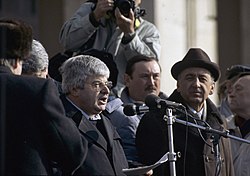- Voter invitation card for the referendum
- People's Deputy of the USSR Yury Afanasyev at a Moscow rally in support of Boris Yeltsin and the Russian presidential referendum
- Boris Yeltsin campaigning in support of the referendum
- Moscow mayor Gavriil Popov at a rally in support of the referendum
17 March 1991 | ||||||||||||||||||||||
Do you consider it necessary to introduce the post of President of the RSFSR elected by popular vote? | ||||||||||||||||||||||
| Results | ||||||||||||||||||||||
|---|---|---|---|---|---|---|---|---|---|---|---|---|---|---|---|---|---|---|---|---|---|---|
| ||||||||||||||||||||||
 Yes: 50–60% 60–70% 70–80% 80–90% No: 50–60% Vote not held | ||||||||||||||||||||||
 |
|---|
A referendum on creating the post of President of Russia was held in the Russian Soviet Federative Socialist Republic on 17 March 1991. [1] The referendum was held alongside a referendum of the preservation of USSR. Prior to the referendum, the Russian head of state was the Chairman of the Supreme Soviet of the Russian SFSR, elected by the Congress of People's Deputies of the Russian SFSR. With 71% of voters approving the proposal, the post of President of the Russian SFSR was introduced, and two months later Boris Yeltsin was elected as the first president.



